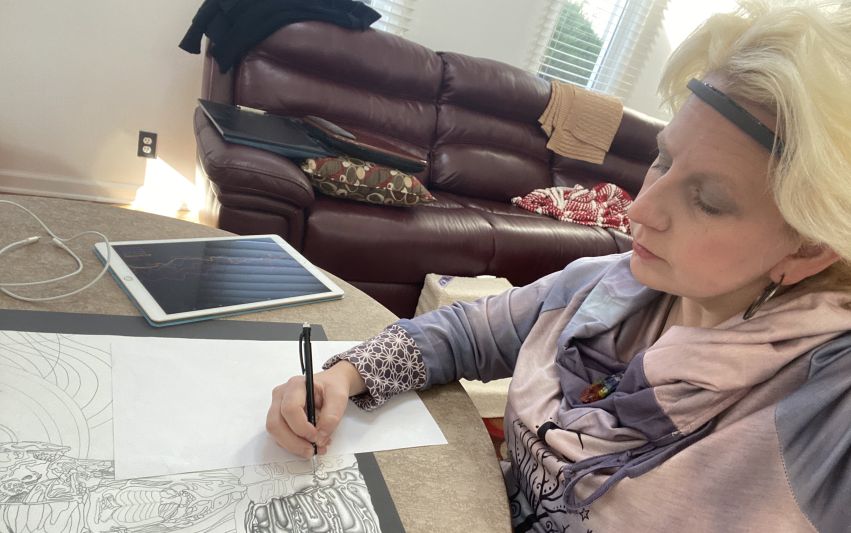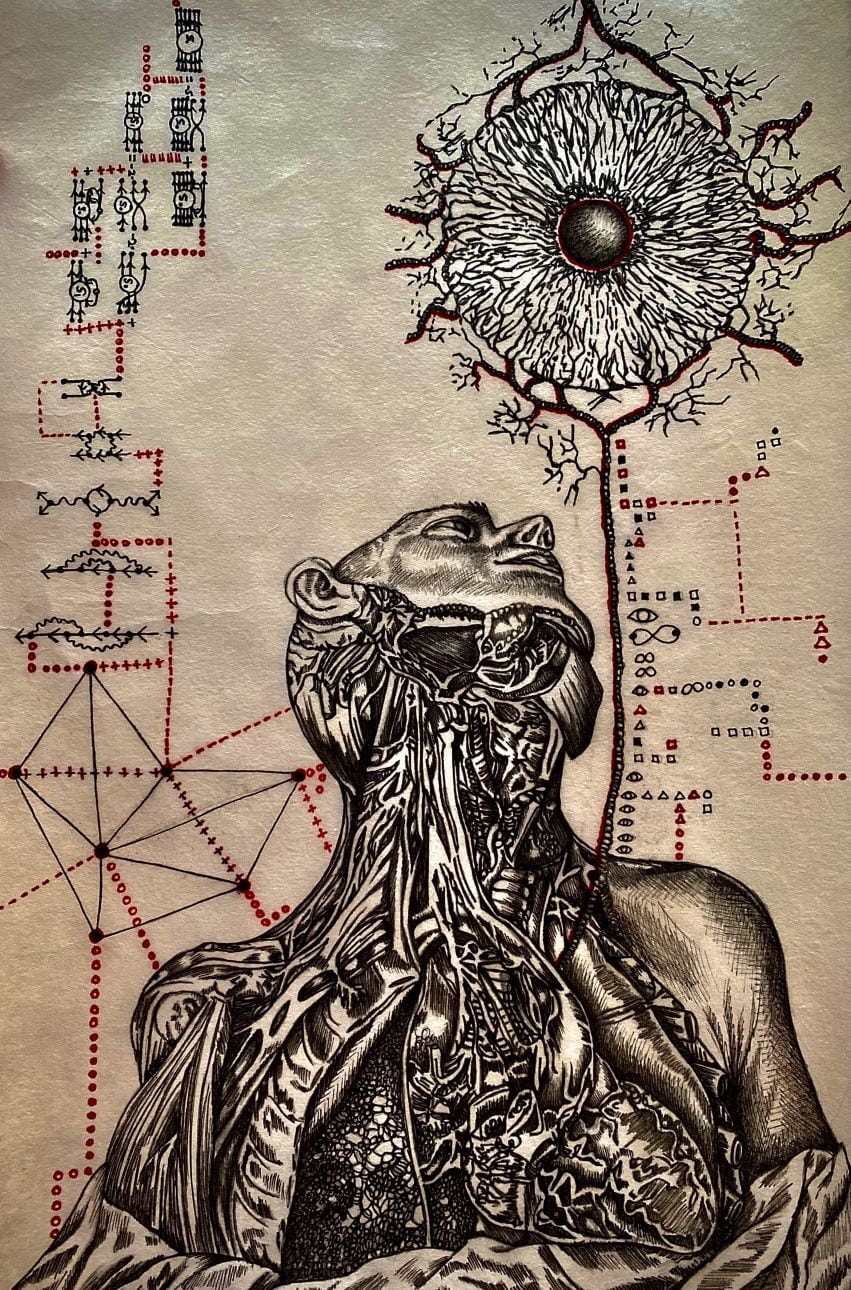Speaking with artist and Bradley University instructor Heather Ford is never a dull event. Before our interview has even begun, she dives into the various works scattered on her living room floor, full of positive vibrations. She smiles and points, explaining highly complex expressions of human consciousness while shooing a feisty dog away from the multi-medium portfolio at her feet.
Ford is not a person one would immediately associate with the tedious work of data visualization. Her perpetual energy does not quite fit the image of poring over spreadsheets like a business intelligence executive. Yet, this is precisely what she has been doing for the last year and a half.
Hand to Paper
Ford’s current work starts by capturing brainwaves via a Muse headband consisting of seven sensors surrounding the head. The device translates electromagnetic biofeedback frequencies—mental activity—into data points, dumping thousands of numbers into a spreadsheet for her analysis. “It took me a semester to come up with how to visually represent this data,” she explains, finally landing on a spiked, circular shape color-coded to EEG (electroencephalography) oscillation frequencies, measured in hertz.

These circles, like nearly every aspect of the artist and her work, are multifaceted and deeply personal. Ford’s spirituality, empathy, connection to nature, and understanding of the collective human consciousness are the threads connecting the distinct periods of her artistic evolution. In this iteration, she translated more than 200 data visualizations of 15-minute drawing-meditation sessions into her concept of the “eye as the window to the soul.”
“I thought it was really interesting that the geometric form of a circle is tied to geometry in relation to nature and spirituality,” Ford offers, reiterating how her art is an extension of her conceptualization of nature and the world around her. Each colored ring represents a different frequency within the brain. Delta, Theta, Alpha, Beta and Gamma are each scientifically recognized and delineated on the Muse website as the touchpoints are recorded.
“Delta, for example, which is the red one, you’re usually asleep or daydreaming. The Theta [fuchsia] is your creativity, dreams and reduced consciousness,” she notes. “Usually, because I’m awake when I’m recording these, they’re low. If I was sleeping, that’s when the red would go high. Beta [green] is when you’re thinking and problem-solving.”
In considering Ford’s work, it makes sense that her Beta waves would be heightened along with her Gamma waves, which represent enhanced perception. As an artist and graphic designer, she is constantly fine-tuning her perception and problem-solving skills.

Formally trained as a fine artist, her foundation for creative expression is forged in painting and drawing. “Hand to paper,” she calls it, though she has never confined herself to any traditional definition of fine art. Knowing her artistic talents had to assimilate to the times, Ford applied her training to graphic design, working as a UI/UX (digital interface and experience) designer professionally for many years. As she operated in the corporate sphere, she added technical expertise, cutting-edge software programs, and digitally native processes to her understanding of art.
In her earlier work, Ford migrated from drawings on paper to digital paintings on her iPad. When printed on canvas in standard museum sizes, even the discerning eye struggles to delineate if they are hand-painted or digital prints. And so began her melding of fine art techniques with commercial graphic design. As she puts it, “I’m using all these UX practices and learned processes, and just applying them in a more traditional, finer way.”
Regardless of the project—whether for her students’ assignments, her community work or corporate design—Ford puts her hand to paper first and sketches out her thoughts. “I think it’s important they’re hand-drawn,” she muses. “There’s a difference from being on the computer because I can’t hit ‘undo.’ You have to make a decision. And it’s a very intuitive decision.”
That intuition drives her current work as she layers brainwave visualizations over graphite-on-paper drawings. It did not surprise Ford to find data supporting the premise that her “flow state”—the highest frequencies—occurs while she is drawing. This is different for everyone, she adds; it comes from a place of concentration and joy. For Ford, that joy is exactly what she hoped to prove when she sought to combine her fine art training with cutting-edge technology and research.
“I said, ‘I wonder if there’s a way I can record myself in moments of meditation and have physical scientific evidence,’” she recalls. “It’s a way to bring science and consciousness and traditional and innovative art and design together.”

Data Visualized
As part of her commercial work and as coordinator of the User Experience Design program in the Department of Interactive Media at Bradley University, Ford sees others stretching the definition of contemporary design alongside her. She regularly attends design festivals where similar concepts have been circulating for years, though she has yet to find others linking meditation and consciousness to analytics and translated into contemporary art. “There are a lot of artists who are doing this in terms of data processing, taking data and putting it into a fine art sector,” she explains, but notes that her particular interpretation is unique.
According to Ford, her studies are supported by researchers at the University of Wisconsin–Madison. For a recent virtual exhibit with Transient, a UK-based online residency program, she references findings that show “an extraordinary synchronization of brainwaves known as gamma synchrony—a pattern increasingly associated with robust brain function during meditation” among Zen Buddhist monks. “I think that, in order to incorporate science, you have to have research and data behind it,” she affirms. “Now being a designer, I’m interested in data and visualization. So as a result, it kind of all came together.”

She credits her community work for this distinctive culmination of science, research, technology, art and consciousness. In recent years, while advocating for Peoria’s homeless community through various art exhibitions, Ford hit a fork in the road. She was on a journey to give voice to the disenfranchised and find fulfillment through what she terms “design for good,” using everything she knew to create change through her art, while deepening her own personal growth. Long before we were all sitting at home by ourselves, Ford was exploring her self-awareness and impact on others. “I think that the collective consciousness when we help others, and we heal others, is what I was doing. But then I said, ‘I have to work on me at the same time.’”
Ford’s brainwave visualization work has taken multiple forms, with each medium specifically chosen for how it represents the data and the meaning she ascribes to it. Lenticulars, which are layered prints akin to holographs, allow the viewer to see shifts in color and shape as they make their way around the work. Ford has also incorporated copper sculptures in her wavelength studies, due to the association between copper and energy. There are data visualizations layered onto scanned graphite drawings, then digitally colored, and hand-drawn figures charred and colored on paper. The next iteration of data will be animated into a fully immersive exhibit for her MFA (Master of Fine Arts) show in the spring of 2022.
As she expertly blends art and technology, Ford leaves no path undiscovered. To complete this final portion of her MFA portfolio, for example, she taught herself to code. “I thought, ‘Wouldn’t it be cool if I learned how to code? I always wanted to learn… Why am I resisting learning how to code? What makes it so awful? You know what, I’m just going to do it.’ So what ended up happening was I took the [raw] data, and I learned how to process it.”
Ford’s spring exhibition will include all of her prior brainwave visualizations, as well as this new, immersive piece. Auditory data visualizations and holographic projections of her brainwaves will surround the viewer as they walk through the installation—a true capstone to her recent work. Without going into detail, she offers a cunning smile and slides into a whisper, suggesting there’s yet another portion of her research yet to come.

Energy for Change
As our conversation wraps, an impatient Morkie makes her presence known, and the artist focuses on the demands of the furry pup. With her needs met, Ford smiles and asks if this all makes sense. The instructor within her shines through, but in no way dampens the delight she takes in explaining her work. It seems she has found a way to harness her internal creative engine. “It’s so strange—it’s like I have to [draw]; I don’t feel fulfilled unless I do. But you know, it’s almost like I shift from one thing to the next…” Then she takes off onto another topic, as fully engaged as ever.
To say Heather Ford is prolific may be an understatement. Between her work as an instructor, her final semester as an MFA candidate, and her community projects, which include sitting on the board of Big Picture Initiative and volunteering throughout Peoria, it is obvious she loves what she does.
As she continues on her mission to “design for good,” Ford makes a profound statement in passing. “I think by having ourselves become our greatest selves, we, in turn, change the world.” And as her current work makes clear, she has harnessed her vibrating energies to complete that very mission. PM
This article was sponsored by Big Picture Initiative. Learn more at bigpicturepeoria.org.




